Ayurveda is the science of health. It believes in the concept of total mind-body healing. Ayurveda teaches us to be calm, patient, and focused, it believes that healing is a beautiful journey, and to be healed is the most beautiful gift that one can give to self. Ayurveda checks the issue of any illnesses right from the roots. There are no band-aid therapies here. No symptomatic treatments. Once you start an Ayurvedic treatment, be assured that the root cause is going to be fixed. And to bring that into action, it has designed some specific diagnostic methods to find the root cause of any illness. One such diagnostic technique is Ashthavidh Pariksha.
Ashthavidh Pariksha is the eight-fold diagnosis plan to reach the core of an illness. These eight diagnostic tools are designed in such a way that they assure to eradicate any illness from its roots. These eight limbs of ayurvedic clinical assessment give us an entire idea of the patients underlying condition.
Ashthavidh Pariksha includes :
- Nadi Pariksha ( Pulse Examination )
- Mala Pariksha ( Stool Examination )
- Mutra Pariksha ( Urine Examination )
- Jivha Pariksha ( Tongue Examination )
- Sparsha Pariksha ( Palpitation and Percussion )
- Shabdha Pariksha ( Voice/ Sound Examination )
- Druk Pariksha ( Eyes/Vision Examination )
- Akriti Pariksha ( General appearance of the patient )
Let’s get to know more about these eight limbs of clinical assessments in detail!
NADI PARIKSHA – PULSE EXAMINATION
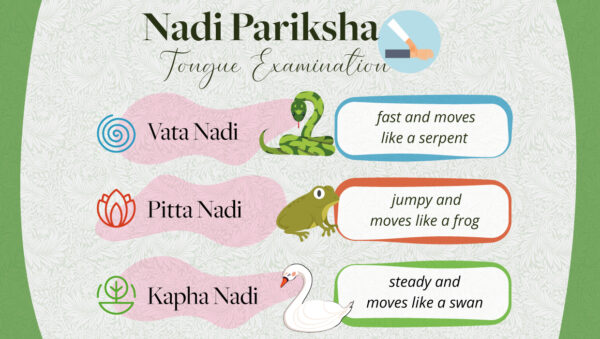
Pulse examination forms the core of Ayurvedic clinical assessment. It gives an idea of the underlying condition of the patient and helps majorly to reach a diagnosis. Nadi’s are the main channels carrying blood and other components within the body. These supreme vessels are one of the most vital components of the body. There are majorly 14 important Nadi’s in the body. During Nadi Pariksha an Ayurvedic doctor may ask you to extend your left arm for a better and more accurate prognosis. The character of the Nadi or pulse is determined by the dosha dominance, for example-
- Vata Nadi is fast and moves like a serpent
- Pitta Nadi is jumpy and moves like a frog
- Kapha Nadi is steady and moves like a swan.
It takes an experienced Ayurvedic doctor to determine and come to a diagnosis on the accuracy of Nadi pariksha as your pulse is influenced by various external factors like your diet, movement, sleep, and stress.
MALA PARIKSHA – STOOL EXAMINATION
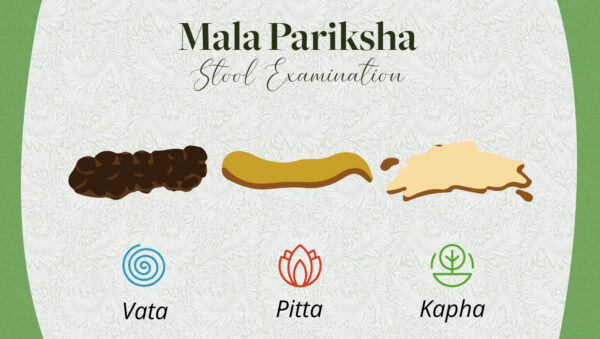
Poop – A subject that most of us are embarrassed to talk about, is in fact a very important indicator of our gut health, digestion, and overall body balance. A person with healthy bowel movements will experience the urge to evacuate first thing in the morning with no pain and pressure. Ideally, regular bowel movements without any discomfort are considered to be healthy!
A stool examination helps gauge the status of your Agni. Agni is the fire element within us that is responsible for critical functions at the cellular levels. These critical cellular functions help keep our metabolism healthy and our mental state balanced. Agni is the sentry that takes stock of what is ingested, digested, and assimilated. Mala pariksha helps us to examine the status of our metabolic fire along with other gut issues.
The color, consistency, smell, etc give us an idea about the dosha imbalance, severity of the condition and also helps us to reach a diagnosis of any illness.
- Stool influence with Vata imbalance may be dry, hard, and appear to have a blackish discoloration.
- Stool influenced with Pitta imbalance may cause a burning sensation and appear yellow in color.
- Stool influenced with Kapha imbalance is slimy and is whitish in color.
MUTRA PARIKSHA – URINE EXAMINATION
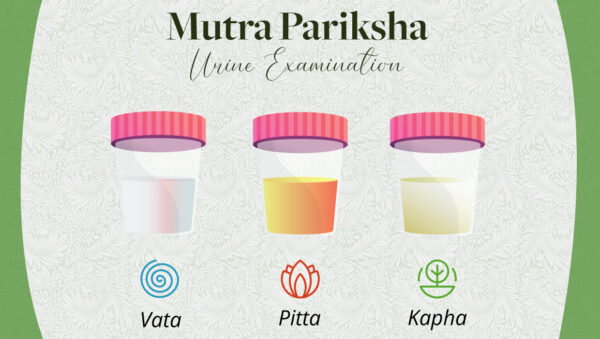
Great scholars of Ayurveda have said that Mutra Priksha as standalone is enough to understand the underlying condition of the patient, owing to its importance and value. The color, consistency, frequency, presence of blood, and sediments give a clear idea of the illness, the dosha imbalance, and diagnosis.
- A Vata imbalance may result in Aruna ( brick red/ bluish ) discoloration of urine, the flow may be scanty and less.
- Pitta imbalance may result in yellowish red-colored urine and one may experience a burning sensation while urinating.
- Kapha imbalance may result in slimy, frothy urine! The consistency may be cloudy depending on the status of the illness.
JIVHA PARIKSHA – TONGUE EXAMINATION
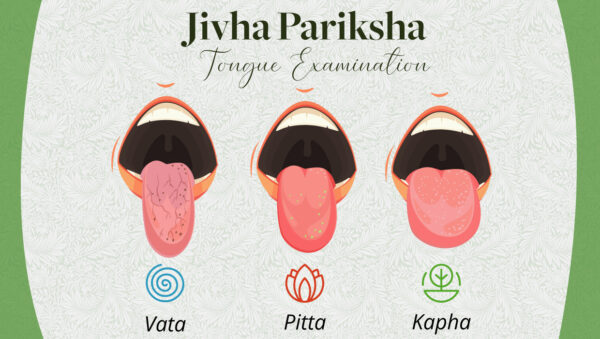
A thick white coating on your tongue right after you wake up in the morning is a clear indication of the presence of Aama in the body. Jivha pariksha is of great importance when it comes to assessing a patient’s condition.
The size, color, inflammation, discoloration, and tongue help us identify the dosha imbalance and reach a diagnosis.
For example :
- Vata dominant tongue is normally fissured and a little dry while Vata vitiation may result in excessive dryness and blackish discoloration.
- Pitta dominant tongue is normally bright red and thin while vitiated Pitta vitiation may result in burning sensation, yellowish discoloration, and foul smell of the tongue.
- Kapha dominant tongue is normally heavy and slimy but vitiated Kapha may result in excessive heaviness, white discoloration and extreme stickiness of the tongue.
SPARSHA PARIKSHA – PALPITATION AND PERCUSSION
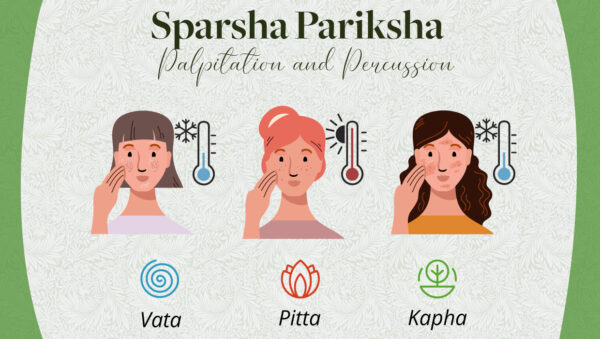
The idea behind this examination is to evaluate the patient’s condition through the medium of touch. We can examine, the texture of the skin, the temperature of the body, tenderness, and the presence of abnormality can be understood by Sparsha pariksha. This helps us to identify the dosha imbalance and reach a diagnosis.
for example,
- Vata individuals generally have a cold body temperature and have rough dry skin.
- Pitta individuals tend to have acne issues, scarring, inflammation and are hot and moist to touch.
- Kapha individuals tend to be cold and wet to the touch, their skin is soft with issues like edema when out of balance.
SHABDHA PARIKSHA – SOUND / VOICE EXAMINATION
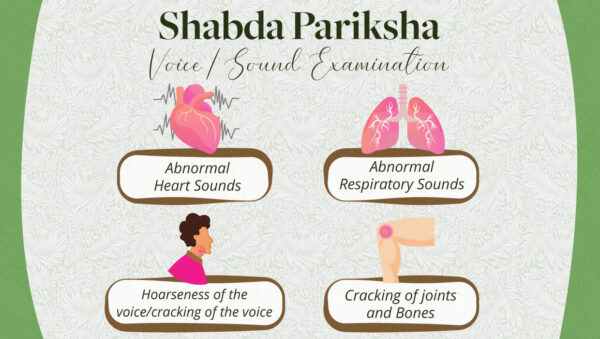
The idea behind this examination is to evaluate the patient’s condition through the medium of sound. Abnormal heart sounds, Abnormal respiratory sounds, murmurs, weakened voices, etc can be accurately picked with Shabdha pariksha. This gives us an idea of the pathogenesis involved and helps in the diagnosis of the illness.
A person’s ability to speak, the hoarseness of the voice, the cracking of the voice it can be easily picked with Shabdha Pariksha.
Moreover, abnormal sounds like wheezing, rhonchi, stridor, abnormal peristaltic sounds, cracking of joints and bones, Coughing, etc when accurately examined helps majorly in the process of diagnosis.
DRUKA PARIKSHA – VISION EXAMINATION
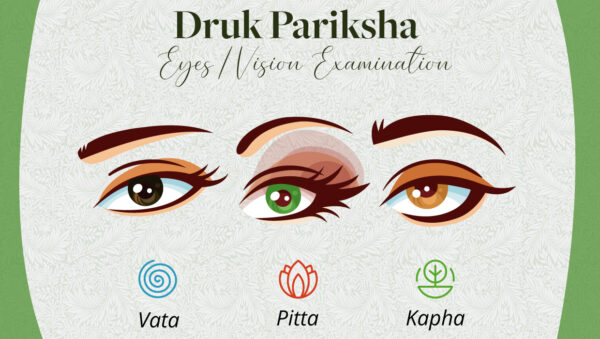
Our eyes give away symptoms of an illness in the terms of color, shape, tears, etc. The color of the eyes, the dryness or excess secretion of fluid, the area around the eyes, etc helps us to identify the dosha imbalance and reach a diagnosis of illness.
They say your eyes are a window to your soul! Apart from the eyes revealing so much about our inner self, they also can be a great indicator of one’s Doshas as well as their imbalances. Here’s a quick and easy guide to examine your eyes through the lens of Ayurveda:
- Vata eyes tend to be small and restless and in an imbalanced state may become excessively dry, nervous and tired.
- Pitta eyes tend to be sharp and piercing and in an imbalanced state may get strained, excessively hot and may burn while showing a reddish discoloration.
- Kapha eyes are generally large and calming but due to a state of imbalance, the eyes may secrete whitish slimy fluid and may feel heavy and fatigued.
AKRITI PARIKSHA – GENERAL APPERENCE OF THE PATIENT

The general appearance of the patient, stature, composition, strength, and weakness are determined by Akriti pariksha. A weekend stature of an individual may suggest depleted Agni as the immunity of the individual is also scarred at the same time. These signals are skillfully picked by an Ayurvedic doctor to determine the cause of your underlying condition and reach an accurate diagnosis.
- Skin Color: Paleness, redness, bluishness in the case of cyanosis, etc are considered as abnormal discoloration and are picked by Akriti pariksha
- Body Weight: Anything apart from ideal BMI weight, whether overweight or underweight is picked by Akriti pariksha and can help in the diagnosis of a condition.
- Body Stature; The structure of your body is recognized in Akriti pariksha and an efficient diagnosis can be made accordingly. Eg, an Extremely emancipated individual may have a Vata imbalance and a weakened Agni.
An Ayurvedic doctor inspects you more holistically to reach and treat the core of your illness. Do not self-diagnose and prescribe and consult an Ayurvedic physician to start your healing journey.
Join us to read more of such articles and support our mission of mindful living for the modern world by subscribing to our blog and hitting us a follow on Instagram and Facebook @sarvedalife.



